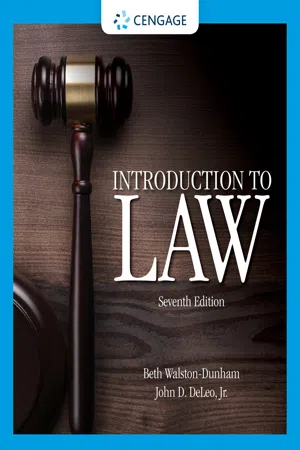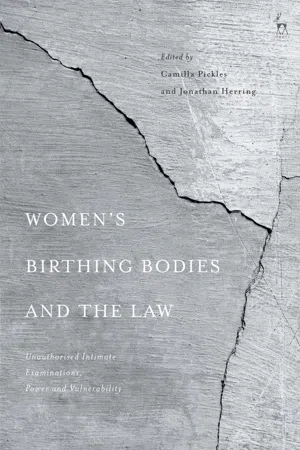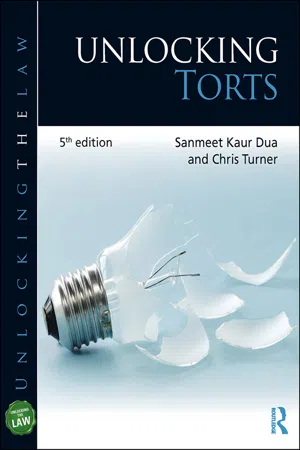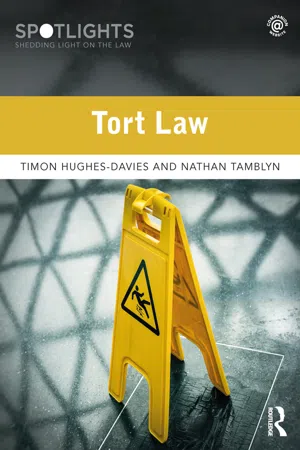Law
Battery Crime
Battery crime refers to the intentional and unlawful physical contact with another person, often resulting in harm or injury. It is a criminal offense and is distinct from assault, which does not necessarily involve physical contact. Battery is typically defined and regulated by criminal law, and the severity of the crime can vary depending on the jurisdiction and the extent of the harm caused.
Written by Perlego with AI-assistance
Related key terms
1 of 5
8 Key excerpts on "Battery Crime"
- eBook - PDF
- Beth Walston-Dunham(Author)
- 2019(Publication Date)
- Cengage Learning EMEA(Publisher)
Thus, criminal assault would be an act that causes fear of immediate physical harm through unpermitted physical contact. 24 BATTERY. Many times in criminal law, the terms assault and battery are interchange-able. When a distinction is made, battery is considered to be the unlawful contact with another person. Such contact can be direct or through an instrument such as a weapon. 25 Like assault, the extent of the contact and the actor’s intent often dictate whether the crime will be prosecuted as a felony or a misdemeanor. Usually, the mens rea required for assault or battery is one of general intent. A person need only be aware that his or her conduct is likely to result in an unpermitted physical contact. Of course, if a more specific intent is present, then that would also be sufficient, but the minimum requirement is only a reasonable awareness. THEFT, ROBBERY, AND LARCENY. In ordinary usage, many laypersons interchange the terms burglary, theft, and robbery. however, as previously indicated, burglary does not include the taking of another person’s property, only the invasion of it. Similarly, theft and robbery are distinct terms, whereas theft and larceny are often synonymous in criminal law. Theft Theft occurs when a party unlawfully obtains the property of another with the intent to dispossess that person of the property. 26 The intent required can be merely CrIMInAL LAW 589 to dispossess, to convert the property to one’s own uses, or to convey the property to another. As long as the intent is to deprive an owner of the use, possession, or owner -ship of property, the mens rea requirement is satisfied. In many jurisdictions, the value of the property influences the severity of the punishment. The theft of more valuable property, usually in excess of a stated dollar amount, is considered grand larceny and is a felony. - eBook - PDF
Women's Birthing Bodies and the Law
Unauthorised Intimate Examinations, Power and Vulnerability
- Camilla Pickles, Jonathan Herring, Camilla Pickles, Jonathan Herring(Authors)
- 2020(Publication Date)
- Hart Publishing(Publisher)
Here, we are directed towards framing this issue as an unlawful and unwanted contact with the body of another. 17 Contrary to Charles Foster’s position in Chapter 7 above, I find it unsurprising that the criminal law is brought into this context. The criminal law demonstrates the wrongs that our society deems especially significant and to not apply the crim-inal law would suggest that the wrongs that women suffer during unauthorised vaginal examinations are not serious enough to capture the criminal law’s atten-tion. 18 This cannot be so. Amel Alghraniet et al remind us that medical practice can involve wrongs that should be the concern of the criminal law because they contra-vene defining values that the state endeavours to safeguard to ensure the good of its citizens. 19 They argue that there is almost an inevitability about the inclusion of criminal law within this space because our criminal laws reflect society’s basic values and it helps to punish those who culpably cause harm or risk of harm. 20 In the context of battery, we are concerned with the fundamental principle that every person’s body is inviolate; so much so that even the slightest touch of another may amount to battery. 21 However, battery concerns more than that because this crime does not necessarily involve the harming of the body ; the Court of Appeal accepts that touching another’s clothing while they wear the item is the equivalent to touching them. 22 Thus, the crime of battery includes a recognition that personal space is something that we value in our society and that it should not be intention-ally or recklessly penetrated without justification. 23 Battery’s broad and gender-neutral definition renders it a crime that encom-passes the touching of any person in any context, and we can and should expect the birth room to be included here. Thus, it has the beneficial potential for univer-sal application. - eBook - ePub
Violence in American Society
An Encyclopedia of Trends, Problems, and Perspectives [2 volumes]
- Chris Richardson(Author)
- 2020(Publication Date)
- ABC-CLIO(Publisher)
Although it lacks a universal legal definition, contemporary American understandings of assault can be traced back to British common law (a law based on judicial precedent rather than statutes), in which it is described as “an attempt, with violence, to do corporal injury to another … As by striking … or any other act done in an angry manner” (Hawkins and Leach 1788, 621). In the event the attempt at injury is successful, the offending individual has committed battery, which was defined in common law as “any injury actually done to the person of another; as spitting in his face; treading on his shoes; [or] jostling him in a revengeful manner” (ibid.). In simple terms, assault can be generally understood as a threat or attempt to cause physical harm to another person, regardless of whether that attempt is successful, whereas battery is the act of causing harm. In this definition, every act of battery will necessarily include assault, but not every assault will include battery. For instance, if one convincingly threatens to cause physical harm to another but does not follow through with the threat, one has only committed assault.The common law definition has served as the foundation for the nation’s legal and cultural understandings of assault and battery, from the colonial period (1607–1775) to the present day. Yet for an act so pervasive and ostensibly simple, assault and battery can quickly become very complicated depending on, among other things, the state in which it is committed, the status or age of the victim and perpetrator, and the relationships between the parties. For example, in Title 8, Chapter 9 of the 2016 California Penal Code, assault is defined as “an unlawful attempt, coupled with the present ability, to commit a violent injury on the person of another” (§ 240). Battery, meanwhile, is defined as “any willful and unlawful use of force or violence upon the person of another” (§ 242). Like the early common law definition, California Penal Code defines assault and battery as separate but related acts. New York Penal Law, on the other hand, indicates that a person is guilty of assault “when, with intent to cause physical injury to another person, he or she causes such injury to that person [or to a third person]” (§ 120.00–1). In New York, as in many other states, the previously separate acts of assault and battery have been combined into a single act.With a small number of exceptions, assault is generally prosecuted under state law, which is specific to the society it is designed to govern. For that reason, the ways in which assault is understood and prosecuted will change based on the context in which it is applied. In order to understand the various ways in which assault is interpreted, perpetrated, and punished in contemporary American society, one must go back to the colonial period and trace its evolution from vague common law to an indispensable element of state and federal law. - eBook - PDF
- Thomas Gardner, Terry Anderson(Authors)
- 2017(Publication Date)
- Cengage Learning EMEA(Publisher)
WCN 02-300 306 PART 2: Crimes Against the Person or angry manner.” Thus, if one intentionally causes another bodily harm, whether by directly striking the person, or indirectly doing so by acts like throwing an object at the person, the crime of battery has been committed. Batteries can be committed with fists, feet, sticks, stones, or other objects used to inflict injury. Under some cir- cumstances, dogs or other animals can be used to commit a battery if they are used to injure another person illegally. 10 If there is physical contact without bodily injury, the contact must be offensive or unwanted. Section 211 of the Model Penal Code combines the common-law crimes of as- sault and battery under the crime of assault. That section does not include “offensive touching” without bodily injury. The MPC limits simple “physical contact” to sex- ual offenses, as discussed below. All states that make battery a crime require that the act to commit a battery must be intentional (or must be done knowingly), because an accidental phys- ical contact or injury is not a battery. However, most states, as in the Kansas statute quoted above, include recklessly causing bodily injury in the definition of battery. Offensive Touching Under Sexual Assault and Sexual Battery Statutes Many states have enacted sexual assault statutes to replace or add to their old rape statutes. These statutes generally provide three or four degrees of sexual assault. In addition to defining sexual intercourse broadly, these statutes also forbid and pun- ish offensive touching. Before the enactment of the sexual assault statutes, offensive touching was ordi- narily charged under the general assault statute or as a battery or disorderly conduct. Although offensive touching may continue to be charged under the old statutes, the sexual assault statute is now available. - eBook - ePub
Criminal Law
Historical, Ethical, and Moral Foundations
- Charles P. Nemeth(Author)
- 2022(Publication Date)
- Routledge(Publisher)
Chapter 5 Crimes against the Person Assault and Other OffensesDOI: 10.4324/9781003284178-5Keywords
Abduct: To carry or lead a person away by threat or use of force or often by fraud.Aggravated assault: A criminal assault that is committed with an intent to cause or that causes serious bodily injury, especially through the use of a dangerous weapon; a criminal assault accompanied by the intent to commit or the commission of a felony.Asportation: The carrying away of someone else’s property that is an element of larceny.Assault: The crime or tort of threatening or attempting to inflict immediate offensive physical contact or bodily harm that one has the present ability to inflict and that puts the victim in fear of such harm or contact.Battery: The crime or tort of intentionally or recklessly causing offensive physical contact or bodily harm that is not consented to by the victim.Domestic violence: Violence committed by one family or household member against another.False imprisonment: The tort of intentionally restraining another by physical force or the threat of physical force without privilege or authority.Force: Violence, compulsion, or constraint exerted upon or against a person or thing.Harassment: Connotes purposeful actions and conduct motivated by a malicious or discriminatory purpose.Hate crime: - eBook - ePub
- Sanmeet Kaur Dua, Chris Turner(Authors)
- 2019(Publication Date)
- Routledge(Publisher)
Different definitions can be found in different sources. Thus:■ ‘Battery is the intentional and direct application of force to another person’ (W V H Rogers, Winfield and Jolowicz on Tort (16th edn, Sweet & Maxwell, 2002), p. 71).■ ‘The application of force to the person of another without lawful justification’ (R E V Heuston and R A Buckley, Salmond and Heuston on the Law of Torts (20th edn, Sweet & Maxwell, 1992), p. 125).■ ‘Battery is the actual infliction of unlawful force on another person’ (Goff LJ in Collins v Wilcock).The problem is that none of these definitions covers all the requisite elements for liability. A better definition is where the defendant, intending the result and without lawful justification or the consent of the claimant, does an act which directly and physically affects the person of the claimant.13.3.2 Ingredients of the tort
Intention
Life would be intolerable and the courts would be overloaded if every touch we received while going about our daily business was actionable. It is clear that the touching must be intentional if there is to be liability for battery, while non-intentional touching may amount to negligence. (See Letang v Cooper in section 13.1.2 .) It must be remembered that it is the touching which must be intentional; it does not matter whether or not the defendant intended to cause injury although this may be relevant to the element of hostility discussed later in this section.A problem can arise where the defendant intends to hit one person but misses and hits someone else. In such cases the doctrine of ‘transferred malice’ comes into play. The intention was to hit someone; the fact that the actual person hit was not the intended target is irrelevant.CASE EXAMPLE
Livingstone v Ministry of Defence [1984] NI 356, NICAA soldier in Northern Ireland fired a baton round targeting a rioter. He missed and hit the claimant instead. It was held that the soldier had intentionally applied force to the claimant. - eBook - ePub
- Timon Hughes-Davies, Nathan Tamblyn(Authors)
- 2019(Publication Date)
- Routledge(Publisher)
As for the difference between battery and assault, by way of a loose example, getting punched would be battery, whereas noticing an imminent punch would be assault. In other words, battery is about contact, assault is about perceiving contact. In popular speech, battery and assault tend to be used interchangeably. Thus, we might hear in the news how a victim was assaulted in the street when they were hit over the head. However, in law, battery and assault are distinct, with different technical requirements, and should be treated as such.____________13.2 Battery
Key learning point
Battery is where the defendant intentionally or recklessly, and unlawfully, makes direct contact with the claimant.In this section, we discuss the following topics: how battery requires intentional or reckless behaviour; how it requires direct contact; how contact must be unlawful; how consent can make contact lawful; and the specific context of giving consent to medical treatment.Intentional or reckless contact
As for the meaning of intentional and reckless, we might take a lead from criminal law:According to R v Woollin,2 an outcome is intentional when a defendant seeks that outcome on purpose. So, if I want to hit you with a snowball, and I throw the snowball, and it hits you, I achieve my goal, and my act was intentional, whether my motive was benign or malicious, and however unlikely I was to find my target.2 [1999] AC 82 (HL).Also, according to Woollin, it may be intentional when an outcome was virtually certain to be the consequence of acting, as the defendant appreciated. A frequent hypothetical example here is when a person puts a bomb on a plane, looking to blow up the plane in order to claim on insurance. They might hope that all the passengers survive, and they do not seek their deaths, but nevertheless they appreciate that passenger deaths are inevitable. In such a circumstance, the bomber can be deemed to intend their deaths.According to R v G,3 a person is reckless when they foresaw a risk, but took it anyway when to do so was unreasonable in the circumstances known to them. In that case, children set fire to some newspapers in a backyard, thinking the fire would burn out on the concrete floor. Instead it spread to the neighbouring shop. The children were not reckless, because they did not foresee the risk of the fire spreading. (If they should - eBook - ePub
Modern Criminal Law
Fifth Edition
- Mike Molan(Author)
- 2013(Publication Date)
- Routledge-Cavendish(Publisher)
The practical joker, such as in Logdon (above), may not intend to frighten his victim, but he will incur liability for assault if he is aware that there is a risk that such might be the case. 7.2.3 Actus reus of battery A battery is the actual infliction of unlawful personal violence. As indicated above, this may occur without P being aware that the actus reus has been committed. The actus reus may be complete as soon as D touches P, or may continue for as long as D continues to apply unlawful force upon the person of P (see Pagan v Metropolitan Police Commissioner [1968] All ER 442). There is no requirement that any force must be directly applied to the person; therefore, if, as in DPP v K, D places acid into an electric hand-dryer, thus causing the next user to be sprayed with the liquid, then that will be a battery, even though D did not spray the acid himself. In Haystead v DPP (2000) The Times, 2 June, the defendant punched W whilst she was holding her child. The force of the blow caused W to drop the child, the child falling to the floor sustaining an injury to his head. Upholding the conviction for the offence of assault against the child by beating, the Divisional Court held that the battery to the child could be caused by the defendant without his having used force directly to the child’s person. The act of W, in dropping the child, could not be regarded as a ‘fully voluntary’ intervening act breaking the chain of causation. It appears that touching a person’s clothing will be regarded as the equivalent of touching the person. In Thomas (1985) 81 Cr App R 331, the appellant was a school caretaker whose conviction for indecently assaulting two schoolgirls was quashed by the Court of Appeal. In one instance, he had touched and rubbed a girl’s skirt. When she objected, he walked away. The court accepted that the touching of a person’s clothing was the equivalent of touching the person who was wearing the clothes
Index pages curate the most relevant extracts from our library of academic textbooks. They’ve been created using an in-house natural language model (NLM), each adding context and meaning to key research topics.







